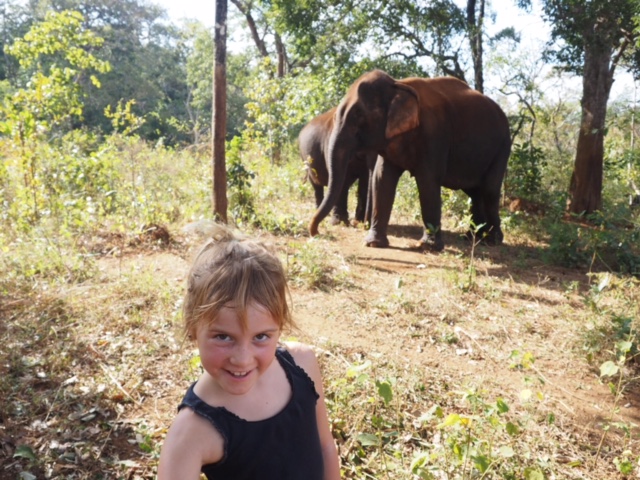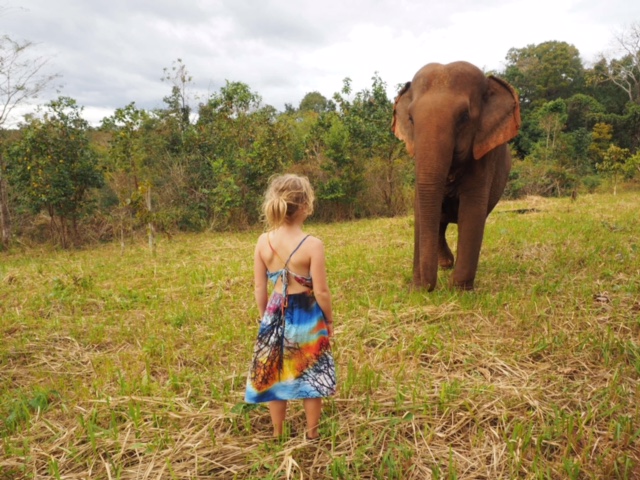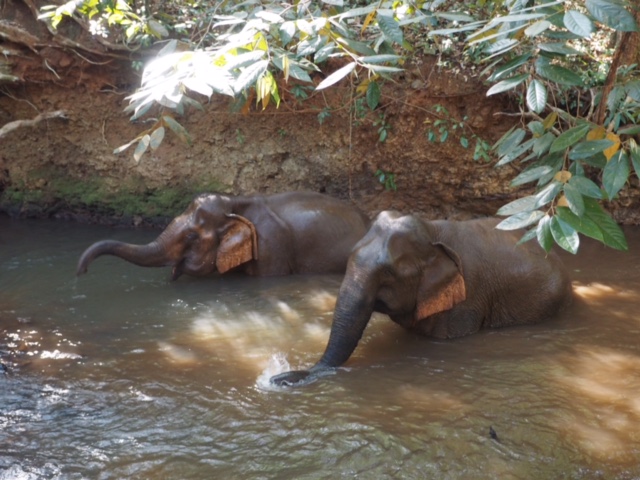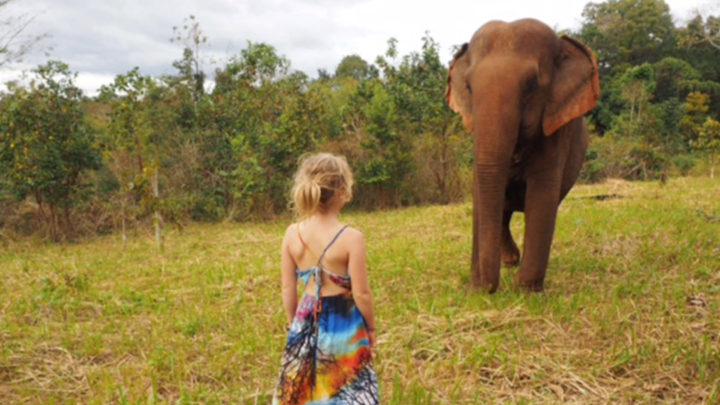Many people still don’t realise that riding elephants as a tourist activity is more than cruel, it’s also supporting an industry that purposely breaks the spirits of baby elephants, inflicts pain daily on elephants held in chains and isolates these magnificent beasts from the forest and their herds for years and years on end.
These beautiful creatures should be roaming the forest, foraging for food and spending time with their social groups. And yet many of them are chained in elephant camps, in agony as they carry uneducated tourists up hills on their backs in scorching heat, pushed onwards by mahouts with bullhooks (many elephants lose their eyes from these hooks) and are given enough food to keep them moving, but not enough to maintain their health. You may notice many elephants will have colourful blankets along their backs under the baskets. This is usually to hide their ribs and disguise their lack of health.

Up close with beautiful eles roaming in the forest as they should be
Please don’t ride elephants! And please let your friends and family know not to support this cruel practice. If they need more convincing here are 10 reasons why we shouldn’t ride elephants.
ELEPHANTS BACKS ARE WEAK
An elephants back is not strong enough to support weight, especially the weight of multiple humans in baskets with metal and wooden bars across their backs.. Baskets with people in them rub and grate on the elephants spine, causing immense pain and creating ulcers, skin abrasions and internal damage. The elephants’ organs are also forced downward by the weight of the basket, constructing their stomach and their ability to eat enough food to maintain their weight and health.
THEIR SPIRITS ARE BROKEN
Elephants aren’t domestic animals, they don’t want you on their backs. They want to be in the jungle, knocking down trees and playing in rivers. So to make them carry tourists and do something totally against their instinct and their spirits need to be broken. They need to be submissive, hobbled souls who are so terrified they allow the mahouts to push them and endure the agony of carrying tourists each day.
To do this baby elephants are tortured for around three days straight in a process called Phajaan or the Crush – because basically the torture will crush the animals spirit. They are tied up, beaten, stabbed with bullhooks and starved until their eyes are dull and lifeless and they cease to resist. Now the elephant is trained and ready to submit to the will of its owners and carry tourists.
This image by Brent Lewin is disturbing but it shows what the crush is all about. Brent shares his story about traveling to the Myanmar/Thai border to uncover this brutal torture.

Emmie meeting the beautiful Sambo at the Elephant Valley Project
ASIAN ELEPHANTS ARE ENDANGERED
Asian elephants are dying out, their habitat is being destroyed, wild elephants are being stolen from the forest and ‘trained’ and sold to elephant camps or industries like logging and construction. While these activities re supported by tourists they will continue and soon there will be no wild elephants left.
ELEPHANTS ARE SOCIAL
It’s so cool to see elephants in the wild. They talk to each other through squeaks, trumpets and bellows, and they send rumbles through the earth that vibrate 10s of kilometres away and can be heard by other eles. They have distinct personalities and adore being together.
In camps elephants are isolated and can’t enact any natural behaviours. They are lonely for company in their natural surrounds, often they are depressed, with trunks dragging on the ground and ears laying back on their bodies, evidence of their broken spirit.

Eles are social and love hanging together
THEY ARE NOT FED PROPERLY
Elephants need to eat around 150kilos of roughage like roots, grass, bamboo and small trees and saplings every day. They need to be foraging and eating for around 18 hours a day! And this does not mean just eating sugarcane and old bamboo they are thrown at elephant camps. They need a varied diet and lots of it, just to maintain their body weight. And in camps they get very little quality food, they are unable to forage and they are often in poor health. They should be in the wild finding their food and filling their bellies.

Eles love the water to wash and cool off and then throw dirt over themselves to stay cool and protected from the sun.
THEY CAN’T COOL DOWN IN CAMPS
For eles, having a bath in the river isn’t just for fun. Their body has its own cooling system and the area behind their ears is the most important. Behind the eles ears is a network of blood vessels that are close to the surface. This is where elephants release heat and where blood vessels cool down, helping to cool their system by as much as five to ten percent. Elephants that don’t get to bath frequently and are working in dusty, dirty conditions like those at Angkor in Siem Reap lose this ability as their ears become covered in dirt and can no longer cool them down. Last year a young elephant collapsed and died at Angkor from being overworked in 40 degree + temperatures, and was likely unable to cool itself down, as well as carrying tourists on its back in this ridiculous heat. It’s a cruel, cruel industry.

This eles amazing ears are thin and webbed with blood vessels that help cool their entire body
THEY MAY HAVE PIECES OF THEIR BODIES TAKEN
Elephant hair and skin is considered good luck and is used in talismans and jewellery in some Asian countries. Poor Sambo at the Elephant Valley Project had the bottom of her tail cut off – the hairy part – rendering her unable to use her tail to cool her down, swat and touch other elephants – a vital form of communication for elephants. She had also had pieces of her ears cut off and these would have also been used to make charms and trinkets. Please, never buy elephant hair jewellery. You can read all about beautiful Sambo here.
THEIR FEET ARE BURNT ON HOT SURFACES AND TAR ROADS
Now not only is the air and sun hot for these poor elephants, but the ground is also blistering. Elephants have the treads of their feed burnt off by the hot ground, and many develop abscesses up into their legs through the soles of the feet. Every step is pure agony and burns their sensitive feet, burning off the tread and making their soles smooth and painful to walk on. This was one of the many painful injuries Sambo endured – you can read her story here.

This is Sambo getting her betadine bath to help heal the hole in her foot caused by an abscess. He soles of her feet were worn right off and are slowly healing.
A LONG LIFE OF TORTURE
Asian elephants live for around 60 years. Can you imagine being stolen at birth and tortured for your whole life in captivity, never roaming the jungle or hanging with your family or elephant friends but instead being in pain each day, carrying heavy, painful loads on your back in burning temperatures whilst being hungry, thirsty and lonely. It’s an awful way to live.
IT’S JUST PLAIN CRUEL
These majestic, beautiful, caring animals should be in the wild, foraging and enjoying their time. Instead they are chained up in the dirt, given bamboo and sugar cane which is not sufficient for their wellbeing, and removed form their natural environment. It’s a cruel business when the lives of elephants are neglected in order to cater to tourists who want an activity that inflicts so much pain.
Just look into their eyes.
It’s a world of pain.
Please help to end this torture.
WHAT CAN YOU DO:
- Share this story and read and share the below stories.
- Tell everyone you know not to ride elephants – and if friends are traveling to Asia check in with them about their plans.
- Investigate, investigate the elephant sanctuary you choose to visit – make sure it doesn’t do riding and read reviews and ask around. The Elephant Valley Project in Cambodia is brilliant and many people support the Elephant Nature Park in Chiang Mai.
Read more:
If You Love Elephants, Don’t Ever Ride Them. Here’s Why.
7 Secrets You Need To Know About Elephant Riding


Carole
Thursday 11th of January 2018
Great article. I have never considered riding an elephant and surprised by seemingly sensible people I know doing so on holidays so a real lack of knowledge of this cruel industry. I will share post on my Facebook. I hope to be going to Cambodia soon and will look into the sanctuary you've mentioned. Would love to see these beautiful creatures in their happy place!
Evie Farrell
Monday 5th of March 2018
So great to hear! Hope you have a wonderful time.
Lisa
Wednesday 29th of March 2017
EXPOSE THE CONSPIRACY! GOD AND THE DEVIL ARE BACKWARDS!! DON'T LET GUILT-FEELINGS, FEAR AND OTHER KINDS OF EMOTIONAL MANIPULATION RULE YOUR CHOICES IN LIFE!!
http://joyofsatan.org/http://exposingchristianity.org/https://exposingthelieofislam.wordpress.com/
Anuradha Manjul
Tuesday 21st of March 2017
Really nice article. Just one point which I want to highlight is that the concerned authorities and even the entire community should think of rehabilitation of not only the elephants but people who are earning their livelihood because of them.